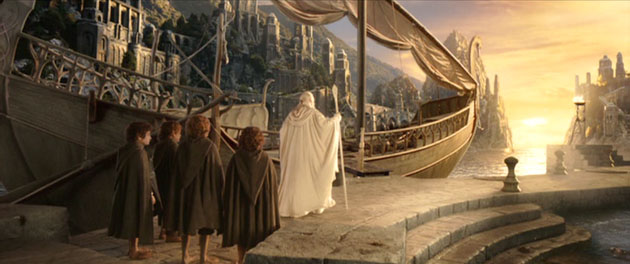Grant Major

AS: What would you say are the attributes of a good production designer? Having that inspiration and at the same time the practicality of making it filmable?
GM: I try to stay fresh and stay young. It’s a competitive business, it’s a speculative business. Try to not pull out the same ideas over and over again. Try to be original and be your own person. Learn how to sell ideas. Ideas go nowhere if you can’t get people to buy into them. A lot of it’s how you frame ideas and how you pitch them to directors and producers. I’ve learned a bit of that along the way as well.
Over time I have been getting a lot more confident. I experimented a lot in the early days and learned a lot of lessons and made mistakes and had successes. There’s no equivalent to just doing it and getting better at it from a technical point of view. People get more confident in you. Your reputation grows so people now can come to you knowing that you can do a project of a size and that you can do it of a standard.
AS: When you are pitching one of these ideas is it a matter of presenting really good set design sketches?
GM: And telling the right story, putting it within context of the greater film. But, yes, the visuals are really important. For example, I’ve been noticing a lot recently how when location scouts go out and take photographs, well, they’re not photographers. You could end up with a good location that may suit you, but you’ve got crap photographs. You have to go back and shoot it yourself. Everything has to be as best as it can possibly be. It has to tell the story you want to tell. So it’s just upping the ante on not just yourself but all the people that work for you as well. Whip them! Whip them hard! (laughs)
AS: How do you go about finding good crew?
GM: All the people I’ve worked with before I seem to hand-pick myself. I’m working on a project in Auckland currently, it’s the second small project I’ve done in Auckland since I’ve been back in the country. And I’m having to look around for who’s hot at the moment. I tend to want to work with them first and give them a chance. If they can maintain a standard and bring me what I need and they get to stay on the next film. These films have a certain lifespan and then you move on to another film so it’s an opportunity to keep people or find new people as I go. Of course in New Zealand there are a lot of people who I know already so that makes things easier. In America I rely a lot on having a good art director who’s got a good team of people he or she can bring in and work with me.
AS: So for the films you’ve done in America, you’ve worked with local crew as opposed to bringing in New Zealand people?
GM: Absolutely. Like I say, the skill base of most of the people I’ve worked with there is phenomenal, brilliant. So it’s worked out pretty well.
AS: As principal photography is going on, do you spend a lot of time on the set?
GM: I start the day on the set, way before call time. I’m the first one there if I can be. But by and large I tend to not hang around on set. It depends a little bit on what’s going on that day. If it’s a very complex day then I’ll hang around for that. In New Zealand and Australia and England we have a Standby Art Director role. The person who leads my onset crew is my standby art director. He keeps me informed on what’s going on and what’s coming up and how the day went. It’s more flexibility for the director on the day without me having to be there.
Tom, this is a wonderful blog, thanks for the info.
Do you have any advice for aspiring production designers? I live in Philadelphia and recently finished architecture school but I very much want to design films.
Glad to hear you like the blog! The best advice I’ve found is to just get out there and start doing it. Work on low budget videos, short films, commercials, anything you can get your hands on for low money. A lot of these directors will call you when they start doing features. And then call you again when the features get bigger budget. K.K. Barrett started with commercials and music videos for Spike Jonze, Grant Major started on smaller movies with Peter Jackson, and Jack Fisk rented a van and brought his own tools out to Colorado to go do Terence Malick’s Badlands. He not only found an auteur to work with throughout his career, he also met his future wife, Sissy Spacek.
Also, you may want to move to LA or New York or anywhere there are schools like USC, AFI, NYU where talented directors are just starting out and looking for designers….
Pingback: STH032: Gandalf the Stern « SQPN: Secrets of The Hobbit
Thanks so much for the response.
I’m actually working on a short film with an old friend of mine who just graduated from USC and is trying to become a director so I guess I am on the right track! He lives in and will be shooting the film in San Diego but we’ve been able to work together so far by way of email and it’s been a lot of fun. I guess I will see what comes of it! If nothing else I’ll have some material to add to my portfolio.
Thanks again!
Pingback: Laurence Bennett
Pingback: Rick Heinrichs
Pingback: STH032: Gandalf the Stern - SQPN.com